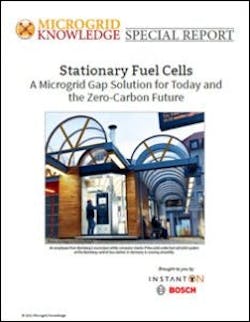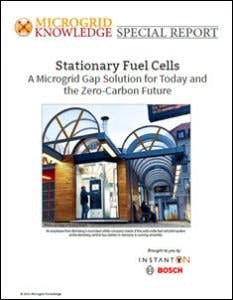The Business Model for Fuel Cells as a Win for Customers and Installers
In a new special report series brought to you by Microgrid Knowledge, Instant On and Robert Bosch, we explore how fuel cells can be a microgrid gap solution that fills the power gap, the fit gap and the sustainability gap. This fifth article explores how the fuel cell business model can be a win for both customers and installers.
Download the full report.
Experienced microgrid developers and DER installers know that the promise of new energy systems often comes into conflict with installation and integration challenges. These challenges blow up customers’ financial models and result in workarounds made on the fly that add costs and complexity in order to deliver customer requirements for the system. In general, there are two primary areas where gaps emerge between planning and reality.
Financial modeling challenges
For a DER such as solar PV, residential, commercial and industrial customers generally don’t get all the power they need from the equipment, which means they need to assess the complexities of local net metering policies to develop an accurate financial model. In this example, they also need to bake generation, transmission and distribution charges into their model.
Unlike solar, fuel cells can truly deliver to customers all the power they require. This would mean no net metering complexities and lower (or no) charges for generation, transmission and distribution in the financial modeling. The blended rate per kWh of electricity from a fuel cell — primarily consisting of the fuel cost — is much simpler to calculate and is more bankable for the purposes of acquiring financing than the energy charges covered in solar power purchase agreements.
Permitting, regulatory and interconnection challenges
Diesel generators come with inherent permitting and regulatory issues, given their use produces NOx and particulate emissions. In many urban areas, the noise created by running diesel generators is another permitting obstacle. Fuel cells avoid these issues with quiet power and heat generation with near-zero emissions of NOx and particulates.
Another emerging permitting advantage comes via how local officials define fuel cells. In one recent small-scale fuel cell project, the fuel cell was successfully integrated into a home after being classified as a gas appliance, similar to a gas clothes dryer or water heater.
If states, cities and utilities take the right approach to this form of power generation, they can avoid the cumbersome permitting processes that accompany not only large diesel generators but also solar installations. Solar installers and microgrid developers are increasingly on the record with complaints about utility interconnection rules and delayed approvals — which can be costly. The project developers for six school microgrids in Salinas, California, shared that Pacific Gas & Electric interconnection delays and a lack of standard utility interconnection procedures for solar plus storage systems that have a resilience component were among their biggest challenges.
For more information, download the full report.
If fuel cells are treated similarly to gas appliances, installers could be granted access to an expedited, standardized interconnection process. In many service territories, utility rules and regulations on fuel cell installation and grid connection are still emerging.
Business model benefits for the installer/developer
If they prefer, customers can purchase and own their fuel cells. Depending on project size, this option can offer customers a three- to seven-year payback period, and it provides installers an opportunity to quickly complete a job with a comparatively simple installation and integration process.
However, many installers and developers are looking for a longer relationship with customers as well as opportunities for additional revenue. Fuel cells can be offered to customers via an energy-as-a-service (EaaS) model that provides continuing revenue. Fuel cells require more servicing and O&M than “set-it-and-forget-it” residential solar panels, so it makes sense to establish EaaS as a model.
Utility rules and regulations, and state and local rules governing fuel cell installation and grid connection are still emerging. Because of this uncertain landscape, fuel cells today aren’t guaranteed to deliver their full potential in terms of quick, easy, affordable installation and integration. That’s why it’s critical that microgrid developers, EPCs and other service providers advocate for fair and business-friendly rules for fuel cells, which in Europe are already on a rapid growth curve thanks to supportive policy. Fuel cell supporters should advocate for an optimal business model enabled by several key market structures:
- A regulatory and permitting structure that allows for a simple installation process, such as that for home gas appliances.
- A utility tariff structure that would allow for fuel cell EaaS to be allowed.
- On-bill gas financing for fuel cells.
- Incentives promoting the use of clean hydrogen-ready appliances, such as those that use fuel cells.
- Behind-the-meter interconnection.
If that advocacy sounds like work, it is. But remember: Early solar installers had to fight many of the same fights to create the multibillion dollar industry that exists today. Fuel cells today are in a similar position as solar a decade ago, and the early adopters who push them forward will win a huge market opportunity.
To learn more about how fuel cells can be a microgrid gap solution, check out the previous articles in the series below:
Stationary Fuel Cells Are a Microgrid Gap Solution
Customers Need a Microgrid Gap Solution. Fuel Cells Are It.
Solid Oxide Fuel Cells: A Definitive Guide
Fuel Cells Offer a Transition to — and a Product for — the Energy Future
Download the full report, “Stationary Fuel Cells: A Microgrid Gap Solution for Today and the Zero-Carbon Future,” courtesy of Instant On and Robert Bosch to learn more.

